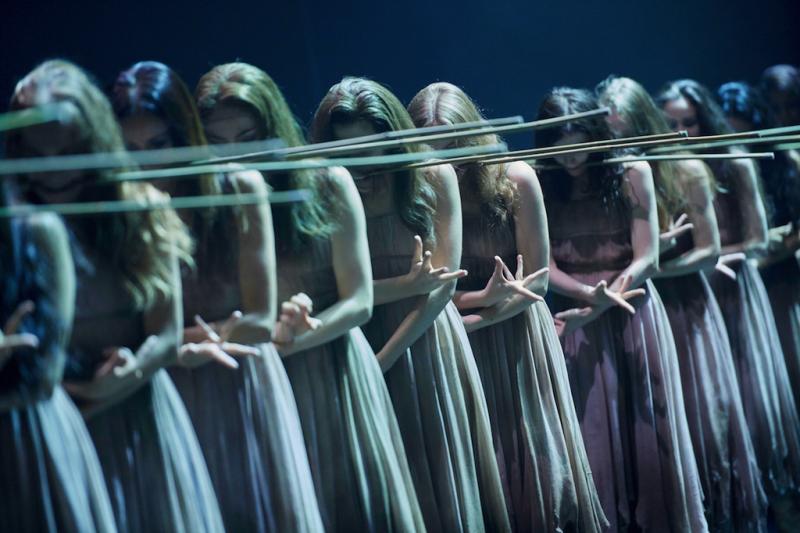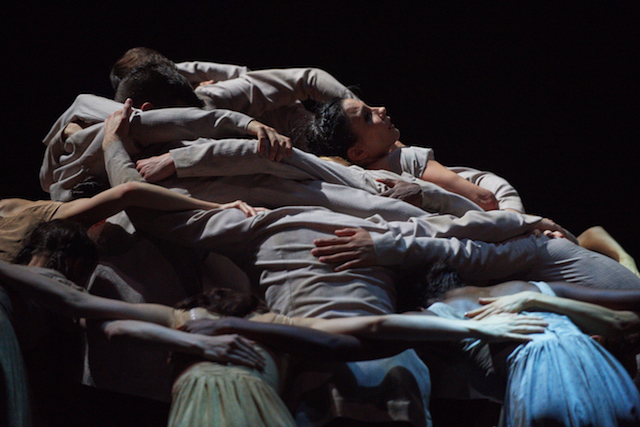Akram Khan's Giselle, Sadler's Wells review - the migrant crisis in a ballet thriller | reviews, news & interviews
Akram Khan's Giselle, Sadler's Wells review - the migrant crisis in a ballet thriller
Akram Khan's Giselle, Sadler's Wells review - the migrant crisis in a ballet thriller
English National Ballet gives us the wilis, and then some

Of the many good reasons for seeing Akram Khan’s 2016 remake of Giselle – his work is often a headline event, for one – the most compelling is the company performing it. English National Ballet used to be the poor relation of its plusher sister national flagship in WC2. Not any more.
"Demonic" is the only word for the ferocious energy and precision with which ENB’s dancers deliver Khan's extraordinary feat of re-imagination. It can’t strictly be called a radical reimagining because the original story is still clearly discernible, albeit displaced, and even wisps of the old Adolphe Adam score are retained, which will please those who like something to hum on the way home. But it’s pleasingly thorough in identifying and recasting the most compelling features of the 1841 storyline – the focus on a spirited young woman whose optimism and love of dancing threatens the status quo, the terrible consequences of that optimism, and retributive justice. Where Giselle Mark 1 was a tale of forelock-tugging European peasantry crushed by the local aristocracy, Khan’s Giselle is that of a horde of rootless migrant workers, locked out by fatcat factory landlords. Vincenzo Lamagna’s score – for live orchestra meshed with pre-recorded sounds – establishes the change of scene, the change of century, in the first few seconds with its ominous grindings and rumblings cut with Asian accents of drums and ankle bells. Tim Yip’s stage design is a vast pitted wall which variously comes to represent a national boundary, a citadel, the limits of a giant factory – whichever, it’s efficient at keeping the great unwashed out. The opening shows a massed line of bodies ceaselessly, hopelessly pushing at it. Khan’s revision of the story hinges on the plight of low-paid workers in the global textile industry, whose economic fluctuations led whole communities to abandon rural lives – whether in Lancashire or Bangladesh – only to be left high and dry when the factories closed and investment moved elsewhere.
Vincenzo Lamagna’s score – for live orchestra meshed with pre-recorded sounds – establishes the change of scene, the change of century, in the first few seconds with its ominous grindings and rumblings cut with Asian accents of drums and ankle bells. Tim Yip’s stage design is a vast pitted wall which variously comes to represent a national boundary, a citadel, the limits of a giant factory – whichever, it’s efficient at keeping the great unwashed out. The opening shows a massed line of bodies ceaselessly, hopelessly pushing at it. Khan’s revision of the story hinges on the plight of low-paid workers in the global textile industry, whose economic fluctuations led whole communities to abandon rural lives – whether in Lancashire or Bangladesh – only to be left high and dry when the factories closed and investment moved elsewhere.
Giselle is part of this outcast community; Albrecht, unknown to her, is the scion of an industry magnate. Hilarion, who also loves her, is a fast-moving wheeler-dealer who slips between both worlds and has every reason to betray his rival’s secret. The scenario is clever all right, but the greater achievement is the clarity of Khan’s storytelling in the midst of thrilling massed movement. He has clearly made a close study of past masters, Pina Bausch most obviously, but he gives the work a personal stamp by drawing on shapes and poses from his own dance heritage, kathak, in temple-dome arms and cactus-spike fingers. He even manages to incorporate salient features from mid-19th century ballet – the fast, beaten jumps, the arabesque – without jarring. This is a migrant community with a wide-ranging folk memory.
This Queen of the Wilis issues her threats by means of what can only be described as an intensity of quivering
It would be something of a spoiler to describe how Khan reproduces the spook-factor of the original second act, in which the so-called wilis, the ghosts of betrayed young girls, hunt down passing men and take their revenge. Let’s just say he matches it, surpasses it even. The person behind me was audibly enthralled, and quietly sobbed throughout the final minutes. Khan’s Giselle goes far beyond the love story: it’s also a wake-up call to the plight of the world’s disposessed, and just like Bathilde, Albrecht’s fiancée, we are all almost certainly wearing a piece of their wretched labour on our backs.
Tamara Rojo led the cast on opening night with a passionate authority, with James Streeter a winning Albrecht and Cesar Corrales a hyper-athletic Hilarion. Stina Quagebeur made a particularly terrifying Myrtha, Queen of the Wilis. I’ve rarely witnessed such dramatic power from a dancer who barely moves from the spot, issuing her threats by means of what can only be described as an intensity of quivering.
Casts will change, but the two biggest stars of the night will not. One of them is the ENB Philharmonic conducted by the tireless Gavin Sutherland. It’s no fun working to a click-track in a hot dark pit, but the result of their efforts is stunning. The other star turn is the corps de ballet with their Olympic stamina and fiendish unison attack, demons indeed.
rating
Explore topics
Share this article
Add comment
The future of Arts Journalism
You can stop theartsdesk.com closing!
We urgently need financing to survive. Our fundraising drive has thus far raised £49,000 but we need to reach £100,000 or we will be forced to close. Please contribute here: https://gofund.me/c3f6033d
And if you can forward this information to anyone who might assist, we’d be grateful.

Subscribe to theartsdesk.com
Thank you for continuing to read our work on theartsdesk.com. For unlimited access to every article in its entirety, including our archive of more than 15,000 pieces, we're asking for £5 per month or £40 per year. We feel it's a very good deal, and hope you do too.
To take a subscription now simply click here.
And if you're looking for that extra gift for a friend or family member, why not treat them to a theartsdesk.com gift subscription?
more Dance
 'We are bowled over!' Thank you for your messages of love and support
Much-appreciated words of commendation from readers and the cultural community
'We are bowled over!' Thank you for your messages of love and support
Much-appreciated words of commendation from readers and the cultural community
 iD-Reloaded, Cirque Éloize, Marlowe Theatre, Canterbury review - attitude, energy and invention
A riotous blend of urban dance music, hip hop and contemporary circus
iD-Reloaded, Cirque Éloize, Marlowe Theatre, Canterbury review - attitude, energy and invention
A riotous blend of urban dance music, hip hop and contemporary circus
 How to be a Dancer in 72,000 Easy Lessons, Teaċ Daṁsa review - a riveting account of a life in dance
Michael Keegan-Dolan's unique hybrid of physical theatre and comic monologue
How to be a Dancer in 72,000 Easy Lessons, Teaċ Daṁsa review - a riveting account of a life in dance
Michael Keegan-Dolan's unique hybrid of physical theatre and comic monologue
 A Single Man, Linbury Theatre review - an anatomy of melancholy, with breaks in the clouds
Ed Watson and Jonathan Goddard are extraordinary in Jonathan Watkins' dance theatre adaptation of Isherwood's novel
A Single Man, Linbury Theatre review - an anatomy of melancholy, with breaks in the clouds
Ed Watson and Jonathan Goddard are extraordinary in Jonathan Watkins' dance theatre adaptation of Isherwood's novel
 Peaky Blinders: The Redemption of Thomas Shelby, Rambert, Sadler's Wells review - exciting dancing, if you can see it
Six TV series reduced to 100 minutes' dance time doesn't quite compute
Peaky Blinders: The Redemption of Thomas Shelby, Rambert, Sadler's Wells review - exciting dancing, if you can see it
Six TV series reduced to 100 minutes' dance time doesn't quite compute
 Giselle, National Ballet of Japan review - return of a classic, refreshed and impeccably danced
First visit by Miyako Yoshida's company leaves you wanting more
Giselle, National Ballet of Japan review - return of a classic, refreshed and impeccably danced
First visit by Miyako Yoshida's company leaves you wanting more
 Quadrophenia, Sadler's Wells review - missed opportunity to give new stage life to a Who classic
The brilliant cast need a tighter score and a stronger narrative
Quadrophenia, Sadler's Wells review - missed opportunity to give new stage life to a Who classic
The brilliant cast need a tighter score and a stronger narrative
 The Midnight Bell, Sadler's Wells review - a first reprise for one of Matthew Bourne's most compelling shows to date
The after-hours lives of the sad and lonely are drawn with compassion, originality and skill
The Midnight Bell, Sadler's Wells review - a first reprise for one of Matthew Bourne's most compelling shows to date
The after-hours lives of the sad and lonely are drawn with compassion, originality and skill
 Ballet to Broadway: Wheeldon Works, Royal Ballet review - the impressive range and reach of Christopher Wheeldon's craft
The title says it: as dancemaker, as creative magnet, the man clearly works his socks off
Ballet to Broadway: Wheeldon Works, Royal Ballet review - the impressive range and reach of Christopher Wheeldon's craft
The title says it: as dancemaker, as creative magnet, the man clearly works his socks off
 The Forsythe Programme, English National Ballet review - brains, beauty and bravura
Once again the veteran choreographer and maverick William Forsythe raises ENB's game
The Forsythe Programme, English National Ballet review - brains, beauty and bravura
Once again the veteran choreographer and maverick William Forsythe raises ENB's game
 Sad Book, Hackney Empire review - What we feel, what we show, and the many ways we deal with sadness
A book about navigating grief feeds into unusual and compelling dance theatre
Sad Book, Hackney Empire review - What we feel, what we show, and the many ways we deal with sadness
A book about navigating grief feeds into unusual and compelling dance theatre
 Balanchine: Three Signature Works, Royal Ballet review - exuberant, joyful, exhilarating
A triumphant triple bill
Balanchine: Three Signature Works, Royal Ballet review - exuberant, joyful, exhilarating
A triumphant triple bill

Comments
Yes, everything was brilliant
Perhaps you were seated near
Perhaps you were seated near the amplifiers. I found the volume levels perfectly OK. I'm usually allergic to amplified orchestra (cf Matthew Bourne's shows) because it changes the overall sound, but surely it was necessary in this case because of the meshing of industrial sounds and electronic music. In fact I found those huge crescendos really thrilling.
Fantastic review and so glad
Yes, we were in the First
What ever you do and however
I agree. Such a pity it had
I agree. Such a pity it had such a short second run at Sadler's Wells but there is a reason. When new and quite experimental shows launch, the risk of a flop is too great for theatre managements to book a large chunk of dates one year hence. No doubt ENB will be looking to tour AK's Giselle much more widely 2018/19 or the season after that, and Sadler's Wells will offer a longer London run too.